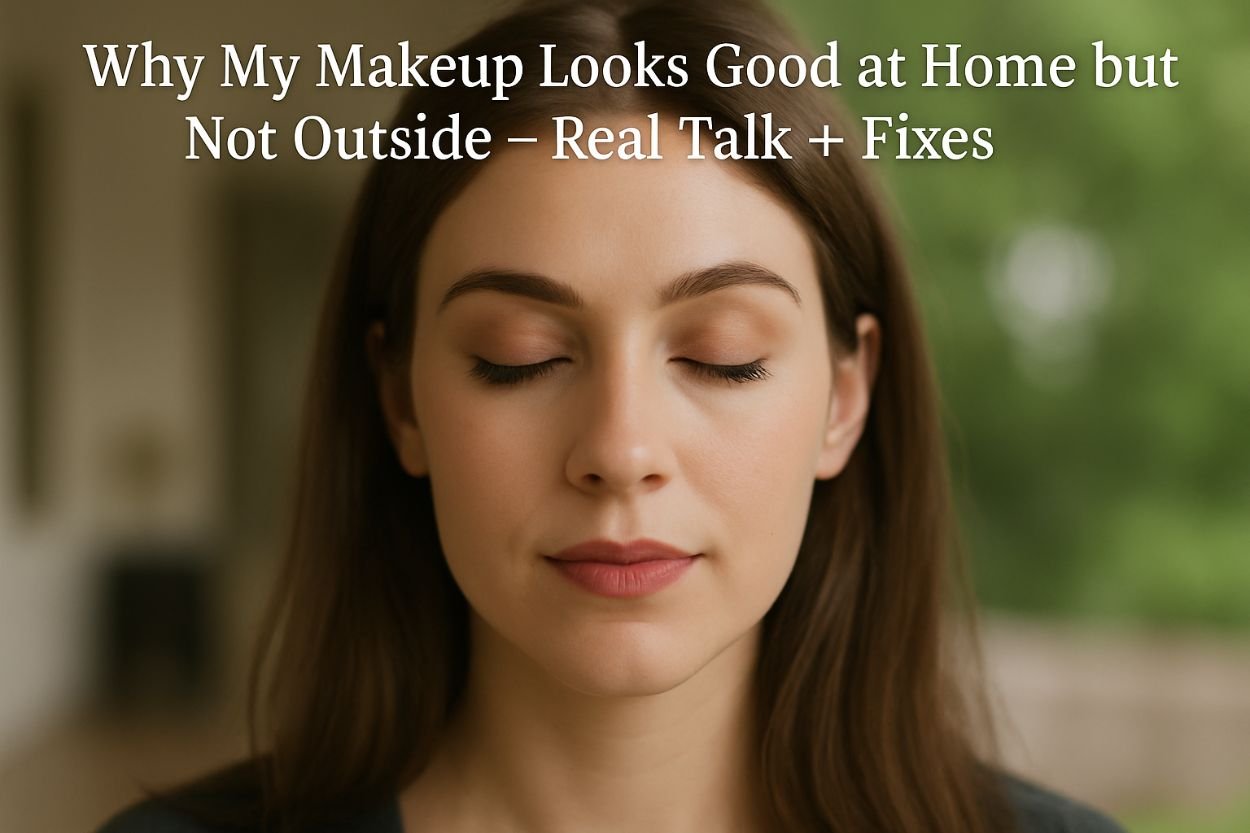Why My Makeup Looks Good at Home but Not Outside – Real Talk + Fixes

Have you ever checked your makeup at home and felt happy, only to step outside and find it looking patchy, grey, orange, or cakey? You are not alone. Many people think this way because makeup behaves differently under natural light, heat, and real-world conditions.
I have spent over three years as a makeup artist and coach, and I have seen this happen with both beginners and seasoned beauty enthusiasts. Today, I will help you understand why it happens and how you can fix it with simple, clear steps.
Why Your Makeup Looks Different Outside
- Lighting at home vs. natural light: Home lighting can hide flaws, shadows, and texture, while sunlight shows everything.
- Oxidation: Some foundations change color after reacting with air and skin oils.
- Application technique: Using too much product or blending poorly can cause unevenness outside.
- Environmental exposure: Heat, humidity, wind, and pollution can change how makeup sits on your skin.
Common Reasons and How to Fix Them
Lighting Issues
Why it happens:
- Bathroom lights often have a yellow tone that makes makeup look warmer and smoother.
- Natural daylight shows the true undertone of your foundation and any dry patches.
Fix:
- Apply your makeup beside a window where natural sunlight can help you see your face clearly.
- Use a daylight-mimicking makeup mirror.
- Take a quick look at your makeup in natural light outside using a mirror before heading out.
Wrong Shade Matching
Why it happens:
- Your foundation may match under warm indoor lights but appear too light, dark, pink, or orange in daylight.
Fix:
- Try foundation shades on your jawline, then step into natural light to see how it really looks.
- Give it 10–15 minutes to see if the color changes (this is called oxidizing).
- Pick a shade with a neutral undertone to avoid noticeable mismatches with your skin.
Texture Problems
Why it happens:
- Dry skin, large pores, or textured skin can look worse under harsh sunlight.
- Heavy powder and foundation can settle into lines and create an uneven texture.
Fix:
- Hydrate: Use moisturizer before makeup.
- Prime: Use a pore-filling or hydrating primer.
- Thin layers: Build thin layers instead of using thick coats.
- Set only where needed: Use powder lightly on the T-zone.
Overuse of Product
Why it happens:
- Heavy layers of concealer, foundation, and powder can appear smooth under warm light but look cakey in other lighting conditions.
Fix:
- Use a damp sponge to blend makeup.
- Use minimal product, focusing only on areas that need coverage.
- Mist your face with a setting spray to melt products into the skin.
Oxidation
Why it happens:
- Certain foundations can change color after application, becoming darker or slightly orange due to contact with air and your skin’s natural oils.
Fix:
- Use a primer to control oil.
- Choose foundations labeled as non-oxidizing.
- Blot excess oil during the day.
Environmental Factors
Why it happens:
- Heat and humidity can cause makeup to slide or separate.
- Cold, dry air can make makeup cling to dry patches.
Fix:
- Use long-wear, lightweight, oil-free foundations.
- Adjust your skincare based on the weather (use hydrating products in winter and oil-control products in summer).
- Keep blotting papers or a setting powder with you for quick touch-ups when your skin gets shiny.
Daily Makeup Routine for Lasting Results
Here is a clear, easy-to-follow daily routine:
| Step | What to Do |
|---|---|
| 1 | Cleanse your face with a gentle cleanser. |
| 2 | Use a moisturizer that matches your skin type to keep your skin balanced and smooth. |
| 3 | Apply SPF (even on cloudy days). |
| 4 | Use a primer (hydrating or mattifying based on your skin). |
| 5 | Use a damp makeup sponge to gently apply a light, even layer of foundation for a natural finish. |
| 6 | Use concealer only where needed. |
| 7 | Lightly set with powder on areas prone to oiliness. |
| 8 | Apply blush and bronzer with a light hand. |
| 9 | Finish with a setting spray to help your makeup stay in place throughout the day. |
| 10 | Carry blotting paper for midday touch-ups. |
FAQs
1. Why does my makeup look patchy outside?
- Due to uneven blending, dry patches, and heavy layering, which sunlight exposes clearly.
2. Should I do my makeup near a window?
- Yes, natural light helps you see how your makeup truly looks.
3. How can I stop my foundation from looking orange?
- Select a non-oxidizing foundation, apply a primer, and test shades in natural daylight.
4. Why does my makeup separate from my nose?
- Excess oil, sweating, or heavy layering can cause separation. Use a mattifying primer and apply it in thin layers.
Conclusion
Your makeup looks different outside because light, air, and environmental factors expose what indoor lighting hides. By:
- Using natural light while applying makeup
- Choosing the right shade
- Applying thin, blended layers
- Managing oil and hydration
You can make your makeup look great outside and inside without frustration.
Remember, skin prep is as important as the makeup you use. Take the time to know your skin’s needs, use suitable products, and apply them in thin layers to avoid a cakey finish.
